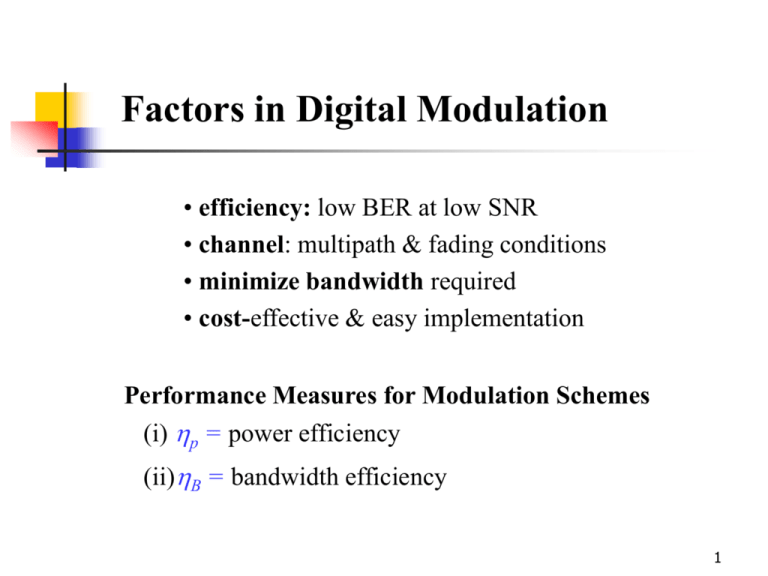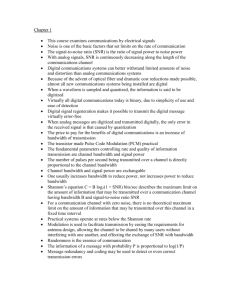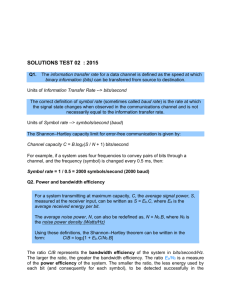lecture 5 intro
advertisement

Factors in Digital Modulation • efficiency: low BER at low SNR • channel: multipath & fading conditions • minimize bandwidth required • cost-effective & easy implementation Performance Measures for Modulation Schemes (i) p = power efficiency (ii)B = bandwidth efficiency 1 Goals in designing a DCS Goals: Maximizing the transmission bit rate Minimizing probability of bit error Minimizing the required power Minimizing required system bandwidth Maximizing system utilization Minimize system complexity 2 Limitations in designing a DCS The Nyquist theoretical minimum bandwidth requirement The Shannon-Hartley capacity theorem (and the Shannon limit) Government regulations Technological limitations Other system requirements (e.g satellite orbits) 3 Nyquist minimum bandwidth requirement The theoretical minimum bandwidth needed for baseband transmission of Rs symbols per second is Rs/2 hertz h(t ) sinc( t / T ) H( f ) 1 T 1 2T ? 0 1 2T f 2T T 0 T 2T t 4 Shannon limit Channel capacity: The maximum data rate at which the error-free communication over the channel is performed. Channel capacity on AWGV channel (ShannonHartley capacity theorem): S C W log 2 1 N [bits/s ] W [Hz ] : Bandwidth S EbC [ Watt ] : Average received signal power N N 0W [Watt] : Average noise power 5 Shannon limit … Shannon theorem puts a limit on transmission data rate, not on error probability: Theoretically possible to transmit information at any rate Rb , where Rb C with an arbitrary small error probability by using a sufficiently complicated coding scheme. For an information rate Rb > C , it is not possible to find a code that can achieve an arbitrary small error probability. 6 Shannon limit … C/W [bits/s/Hz] Unattainable region Practical region SNR [dB] 7 Shannon limit … S C W log 2 1 N S EbC N N 0W Eb C C log 2 1 W N0 W C As W or 0, we get : W Eb 1 0.693 1.6 [dB] N0 log 2 e Shannon limit There exists a limiting value of Eb / N 0 below which there can be no error-free communication at any information rate. By increasing the bandwidth alone, the capacity cannot be increased to any desired value. 8 Shannon limit … Practical region W/C [Hz/bits/s] Unattainable region -1.6 [dB] Eb / N 0 [dB] 9 Bandwidth efficiency plane R>C Unattainable region M=256 M=64 R=C R/W [bits/s/Hz] M=16 M=8 M=4 Bandwidth limited M=2 M=4 M=2 R<C Practical region M=8 M=16 Shannon limit Power limited Eb / N 0 [dB] MPSK MQAM MFSK PB 105 10 Error probability plane (example for coherent MPSK and MFSK) M-PSK bandwidth-efficient M-FSK power-efficient k=5 Bit error probability k=4 k=1 k=2 k=4 k=3 k=5 k=1,2 Eb / N 0 [dB] Eb / N 0 [dB] 11 Power and bandwidth limited systems Two major communication resources: Transmit power and channel bandwidth In many communication systems, one of these resources is more precious than the other. Hence, systems can be classified as: Power-limited systems: save power at the expense of bandwidth (for example by using coding schemes) Bandwidth-limited systems: save bandwidth at the expense of power (for example by using spectrally efficient modulation schemes) 12 M-ary signaling Bandwidth efficiency: Rb log 2 M 1 W WTs WTb [bits/s/Hz ] W 1 / Ts Rs [Hz] Assuming Nyquist (ideal rectangular) filtering at baseband, the required passband bandwidth is: Rb / W log 2 M [bits/s/Hz ] M-PSK and M-QAM (bandwidth-limited systems) Bandwidth efficiency increases as M increases. Rb / W log 2 M / M [bits/s/Hz ] MFSK (power-limited systems) Bandwidth efficiency decreases as M increases. 13





